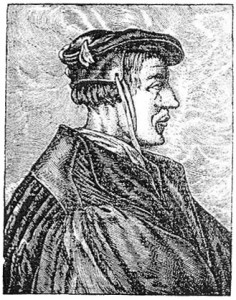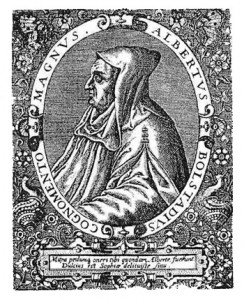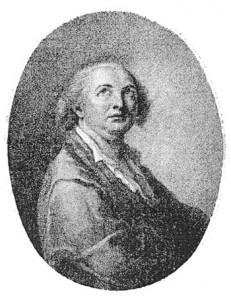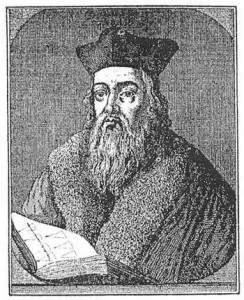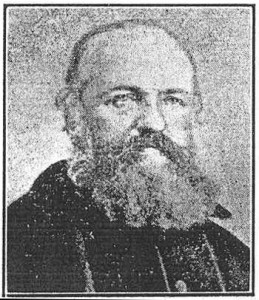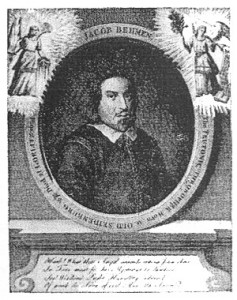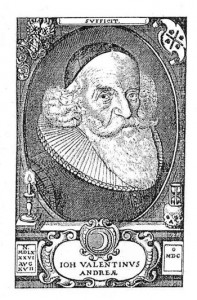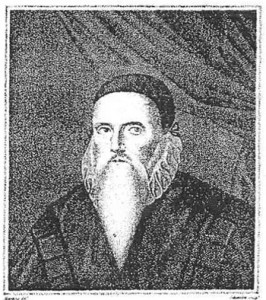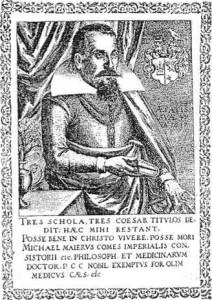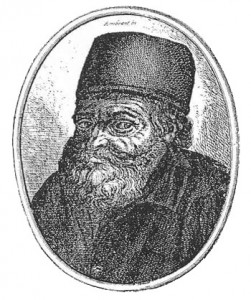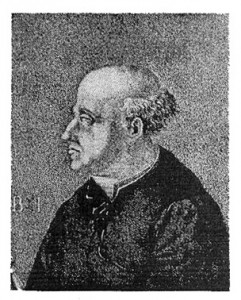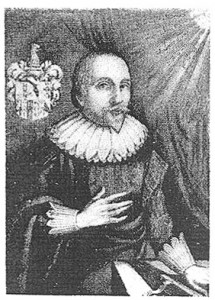(Listed in no special sequence)
Henry Cornelius Agrippa Von Nettesheim
Born at Cogne, September 14, 1486. The name Agrippa suggests the early days of Cologne as the site of the camp of Marcus Agrippa, and the colony of Agrippina. Among the Romans a child who was born feet-foremost was called “Agrippa.” The word as explained by Aulus Gellius was invented to express the idea compounded of the trouble of the woman and the feet of the child.
Agrippa early became a scholar, and a subject of discussion among scholars. Cologne was one of the few cities not priest-ridden, and kept a strict watch upon its Archbishop. The Von Nettersheims were intimates of the Archbishop, and young Cornelius grew up in the service of the Emperor of Germany, Maximilian the First. At 20 he was employed on secret service missions. In 1506 Cornelius went to Paris, ostensibly to the University. While there he met many mystics who hailed him as a natural leader. With them he founded the Rosicrucian Brotherhood in Paris. He was engaged in many adventures and hairbreadth escapes in France, Italy, and Spain.
His “Occult Philosophy” was published in 1538, and the only English translation in 1651. He vigorously defends the title of “Magician” as signifying, “not a sorcerer or one that is superstitious and devilish, but a wise man, a priest, and a prophet.” Publication of his Occult Philosophy was vigorously opposed by the Inquisition, although he had previously acted as theologian to the Council of Pisa under Pope Julius II.
Cornelius practiced as a physician for a short time and suffered imprisonment for debt at Brussels. He was married three times and had a large family. He died February 18, 1535, at Grenoble.
Albertus Magnus
Albert de Groot or von Bollstadt, was born in Suabia, at Larvigen, on the Danube, in 1205. The term “Magnus” applied to him is not the consequence of his great reputation, but it is the Latin equivalent of his family name.
He is accredited with excessive stupidity during his youth but later unfolded the highest intellectual illumination and became one of the greatest doctors of his day. He was made Provincial of the Dominicans, appointed to the Bishopric of Ratisbon, which he resigned to go into conventual retreat at Cologne.
His Opera Omnia comprises twenty-one folio volumes, and in 1480 the Great Chronicle of Belgium records him “magnus in magia, major in philosophia, maximus in theologia.” His singular experiments are recorded in the “Secretum Secretorum” which first appeared at Venice in 1508. Maier states that Albertus received from the disciples of St. Dominic the secret of the “Philosophical Stone” and the mysteries of the “Rosie Cross,” which he afterward communicated to his pupil St. Thomas Aquinas. Albertus taught the possibility of transmutation “when performed upon the principles of Nature.”
He considers that all metals are composed “on an unctuous and subtle humidity, intimately incorporated with a subtle and perfect matter.” He employed alembics for distillations and aludels for sublimations; he also made use of various lutes, the composition of which describes. He mentions alum and caustic alkali, and seems to have been aware of the alkaline basis of cream of tartar. He knew the method of purifying the precious metals by means of lead and of gold, by cementation, likewise the method of testing the purity of gold.
He mentions red lead, metallic arsenic, and liver of sulphur. He was acquainted with green vitriol and iron pyrites. He knew that arsenic renders copper white, and that sulphur attacks all the metals except gold. Albertus Magnus was one of the strongest links in the continuity of the Order during the pre- “C.R.C.” period.
Count Cagliostro
Of his birth and early life nothing is accurately known. He was a member of the Rosicrucian Brotherhood and remained so until his death, which occurred in 1795 after serving four months of a sentence to perpetual imprisonment in Italy, by the Inquisition.
He was confined in the Castle San Leo. Ignorant writers have stated that he was expelled from the Brotherhood, but this is no doubt due to the confusion of his identity with that of the notorious swindler Giuseppe Balsamo.
He became a Freemason in London in 1776, and was an initiate of the “Order of Strict Observance” connected with Masonry. He was the originator of the rituals of “Egyptian Masonry.” At Strasbourg in 1780 he performed the operation of transmutation, and was a miraculous healer of all diseases. His friendship with the Cardinal de Rohan proved eventually his undoing. He suffered many vicissitudes, including imprisonment for his alchemical practices, in the Bastille.
Edward Kelley
Born at Worcester, August 1, 1555. Started life as an apothecary, but later attended Oxford University under the name of Talbot. Studied law and for a time practiced as a notary.
According to tradition, while in the vicinity of Glastonbury Abbey (which by the way, has played such a notable part in so many incidents in Rosicrucian history) he became possessed of a manuscript by St. Dunstan, which inspired him to take up the study of Alchemy.
It is known to a reasonable degree of certainty that he did know both the red and white transmuting tinctures. Kelley had well developed psychical powers, and in 1583 was knighted by the Emperor Rudolph II at Prague, although in 1589 the same Emperor imprisoned him to extort the transmutative secrets from him, in which he was unsuccessful. He was released in 1593, and died in 1595 as the result of an accident incurred while attempting to escape.
Eliphas Levi
The full name, Eliphas Levi Zahed “is a pseudonym which was adopted in his occult writings by Alphonse Louis Constant, and it is said to be the Hebrew equivalent of that name.
Born 1810, the son of a shoemaker. Educated for the priesthood at Saint Sulpice. Later expelled for teaching contrary to the Roman Catholic Church. Known in literature as the “Abbe” Constant. Published the “Gospel of Liberty” for which he suffered six months imprisonment. In spite of his vows he effected a runaway match with Mlle. Noemy, a beautiful girl of sixteen, who bore him two children and subsequently deserted him. The children died in infancy. Madame Constant later became a celebrated sculptor, exhibiting at the Salon under the name of Claude Vingmy. Constant’s occult career began in 1825. He died in 1875, attended by the last offices of the Church, which had nearly expelled him completely.
Levi or Constant was one of the most notable expositors of occult science, although he was more of a transcendentalist than a mystic. Among other notable works his “Dogma et Rituel de Haute Magie” is especially valued by occultists.
Jacob Bohme
Jacob Bohme (Boehme, Bohm, Behmen, Bome, Beme, etc.) may be considered as the central figure of Christian Mysticism. He was born 1575 at Old Seidenberg, two miles from Gorlitz, near the Bavarian border, in what was then German Prussia. Parents were poor peasants. His first experience was retirement into a cave, in the rock called Land’s Crown, where he discovered a large wooden vessel full of money, from which he precipitately fled without touching it, as though it were something diabolical.
He told his companions, but when they attempted to find the spot, there was no cave to be found. Bohme had little schooling and was apprenticed to a shoemaker. One day a benevolent appearing man entered the shop, and beckoning Bohme aside said, “Jacob, thou art as yet but little; nevertheless, the time will come when thou shalt be great, and the world shall marvel at thee. Therefore, be pious, fear God, and reverence the Word. Read the Holy Scriptures diligently; in these thou shalt have comfort and instruction through the misery, poverty, and persecution which are in store for thee. Be courageous and persevere; God loves thee and is gracious unto thee.” The stranger then disappeared leaving Bohme with the determination to be more studious and pious then ever.
In 1594 Bohme married the daughter of a tradesman, by whom he had four children. In 1598 he had his first real ecstasy, surrounded by the divine light, and beholding the nature and virtue of the vegetable world. A similar experience occurred in 1600 when he passed into the hypnotic state by accidentally fixing his eye on a burnished pewter dish. Ten years later his psychic visions had become much clearer and more tangible. From 1619 to 1624 he produced the “Mysterium Magnun” and the “Signatura Rerum.” In 1624 he was attacked by fever at the house of a friend in Silesia, was carried at his own request to his hometown, and on the 22nd November expired in a semi-ecstatic condition. The following lines appear in the “Lives of Alchymistical Philosophers”:
“Whate’er the Eastern Magi sought,
Or Orpheus sung, or Hermes taught,
Whate’er Confucius could inspire,
Or Zoroaster’s mystic fire;
The symbols that Pythagoras drew,
The wisdom God-like Plato knew;
What Socrates debating proved,
Or Epictetus lived and loved;
The sacred fire of saint and sage
Through every clime, in every age,
In Bohmen’s wondrous page we view
Discovered and revealed anew.
‘Aurora’ dawned the coming day;
Succeeding books meridian light display
Ten thousand depths his works explore,
Ten thousand truths unknown before,
Through all his books profound we trace,
The abyss of nature, God and Grace;
The seals are broke, the mystery’s past,
And all is now revealed at last,
The trumpet sounds, the Spirit’s given,
And Bohmen is the voice from Heaven.”
Johann Valentin Andreas
This eminent Lutheran theologian and mystic is especially interesting to Rosicrucians as the one who restored to us from earlier times, the Landmarks essentially as we now have them. He is often regarded as the author of the “Fama Fraternitatis” and the “Confessio” but this is erroneous. On the best authority Francis Bacon, Lord Verulam, may be stated to have been the author of the “Fama” as a comparison of that work with his New Atlantis published in 1626, just before his death, will show.
Andreas’ chief services to the Fraternity were his handling of the publications at Cassel in 1614, and 1615, the first outward admission of the existence of the Order, during the five year period of manifestation then existing. He may be regarded in a way as the “Herald” of the Order during its transition period.
John Dee
John Dee was a mathematician and astrologer of remarkable erudition. Little is known of his ancestry. Through his friendship with Edward Kelley he became a member of the Brotherhood in 1582. On May 10, 1588, he was invested with the Great Secret, and on several subsequent occasions is known to have performed transmutations. Dee’s principal service to the Brotherhood was his research into “crystal gazing.”
He carried on extensive experiments, employing for the purpose a speculum of cannel coal. His ability to communicate with the inhabitants of spiritual spheres was demonstrated on many notable occasions.
Michael Maier
The biography of Michael Maier is especially timely on this anniversary, as that of the Initiate to whom we are indebted for the introduction of Rosicrucianism to the English speaking world.
Maier was born at Rendsburg or Ruidsburg, Holstein, about 1568. He studied medicine, practiced at Rostock, and became physician to the Emperor Rudolph, by whom he was ennobled.
Il se passiona pour le grand oeuvre and scoured all Germany to meet those in possession of transcendental secrets. Became a member of the “College of Teutonic Philosophers R. C.” He introduced the Order into England about 1620. A posthumous volume published in 1624 contains two tracts, the first being entitled “Colloquii Rhodostauroticum trium personarum, per Famam et Confessionem quodanodo revelatam de Fraternitate Rosea Crucis.” The second was entitled “Echo Colloquii.”
He was the most voluminous alchemical writer of his period, publishing almost continually until his death in 1622. Most of his works are buried in a multitude of symbols.
In his Lusus Serius; or, Serious Pastime he supposes a Parliament of the various creatures of the world to meet, in order that Man might choose the noblest of them all as king over the rest. The Calf, the Sheep, the Goose, the Oyster, the Bee, the Silkworm, Flax, and Mercury are the chosen representatives, each of which discourses in turn. It will be unnecessary to state that Mercury wins the day. Thus does Maier eulogize it; “Thou art the Miracle, Splendor, and Light of the World. Thou art the Glory, Art, Ornament and Supporter of the Earth. Thou art the Aysle, Anchor and Tye of the Universe. Next to the Mindle of Man, God created nothing more Noble, or more Profitable.”
His Subtle Allegory concerning the Secrets of Alchemy, very useful to possess and pleasant to read, will be found in the Hermetic Museum, together with his Golden Tripod.
Nicholas Flamel
The name of this Adept is profoundly venerated. The date of his birth is uncertain, but was about 1330, during the reign of Philippe le Bel, the spoliator of the grand order of the Temple.
Flamel’s parents bequeathed him a small house, which he continued to possess till his death. It stood in Notary Street at the corner of Marivaux Street, opposite the Marivaux door of the Church of Saint-Jacques-la-Boucherie, Paris.
A scrivener by profession, he became proficient in painting, poetry, architecture, and the mathematical sciences. He married a widow named Pernelle, over forty, handsome and wealthy. He was elected a member of the “Illuminated Sons of the Doctrine,” and received the vision of the Bath-Kol, who appeared to him bearing a book in well wrought copper, the leaves of thin barl, with characters of gold, graven carefully with a pen of iron.
His will still exists in the archives of St. Jacques and he died three years after making it, in 1419. Tangible evidences of his transmutations were still in existence up to 1742.
Paracelsus
Philippus Aureolus Theophrastus Bombast von Hohenheim known as Paracelsus was born in 1493 at Maria Einsiedeln, Canton of Zurich, Switzerland. Descended from ancient Bombast family of Castle Hohenheim near Stuttgart, Wurtemberg. His father, a physician of repute, possessor of curious books and his mother, matron of a hospital.
Theophrastus, born a year after their marriage. Said to have been emasculated from infancy which accounts for his beardless face and feminine appearance and hatred of women. Studied Alchemy, surgery and medicine with his father. Stimulated to the higher studies by works of Isaac Holland. Continued his studies under monks in Convent of St. Andrew of Savon, later University of Basel. Finally devoted himself to occult science under illustrious Johann Trithemius, Abbott of Spanheim. Later studied under Sigismund Hagger. At age of twenty traveled through Germany, Hungary, Italy, France, Netherlands, Sweden, Denmark and Russia.
In Muscovy was made prisoner and taken to court of the “Great Cham.” Acquiring favor was sent to embassy at Constantinople where he was given the sublime secret of Alchemy by a generous Arabian who gave him the universal dissolvent, the Azoth of Western Adepts, that Alcahest or Sophic fire. Thus initiated he traveled through India and Egypt. At age of thirty returned to Germany and performed many marvelous cures. In 1528 proceeded to Colmar. In 1530 he was denounced in Nuremberg as an impostor but confounded his critics by marvelous cures of elephantiasis, of which testimonials are extant in the archives of Nuremberg.
Died after many wanderings, on the 24th of September 1541. Traditions regarding his death differ. One states that he died on a bench of the kitchen fire at the Inn at Strasburg. Another states that “he went to Maehren, Kaernthen, Krain, and Hungary, and finally landed in Salzburg, to which place he was invited by the Prince Palatine, Duke Ernst of Bavaria, who was a lover of the secret arts. He died there after a short illness, at the age of forty eight years and three days, in a small room of the White Horse Inn near the quay, and was buried in the graveyard of St. Sebastian. His death is said to have been hastened by a scuffle with assassins in the pay of the orthodox medical faculty.” He was one of the greatest and most illustrious of the long line of notable Alchemists and Initiates of the Order.
Robert Fludd
Dr. Robert Fludd better known to occultists as Robertus de Flactibus was born at Milgate House, Parish of Bearsted, County of Kent, England, in 1574. Of all English operative magicians he alone is invariably known as “The Great English Rosicrucian.” The arms and monuments of the Fludd family are still to be seen in Bearsted Church.
He was a fifth son. At 17 entered St. John’s College, Oxford; graduated B. A. February 3, 1596-7; M. A. July 8, 1598. Received degrees in same class with William Laud, later the famous Archbishop of Canterbury, of whom he was an intimate friend.
Studied Physics and Medicine; traveled in France, Spain, Italy, and Germany for six years and later studied in Arabia and Egypt. Performed marvelous cures and experiments, one of which is recorded as “extracting a deadly venom, most pernicious and malignant out of a man.” Returned to England, entered Christ Church College, Oxford. Received degrees of M. B. and M. D. May 16, 1605. Made a Fellow September 20, 1609. Censor 1618, 1627, 1633, and 1634. Practiced medicine in London in Fenchurch Street, afterwards in Coleman Street maintaining a handsome establishment.
During his Fellowship it was said of him, “with a large share of egotism and assurance, a strong leaning toward chemistry, a contempt of Galenical medicine and a sincere belief in the doctrines of the Rosie Cross – he startled the Censors by his conduct within the College no less than by his conduct without it.”
Michael Maier introduced the Rosicrucian Order into England, about 1620, but although he and Fludd were friends, Fludd was initiated abroad.
Dr. Robert Fludd died September 8, 1637, at his house in the Parish of St. Catherine, Coleman Street. His place of rest in Bearsted Church is marked by a “Stone” prepared by himself.
His first book was “Apologia Compediaria Fraternitatem de Rosea Crucis Suspicionis et Infamiae Maculis Aspersam, veritates quaesi Fluctibus abluens et abstergens. Laydae 1616. Fludd declares its purpose to be “to protect the purity of the Society, and to wipe off the spots of shame smeared over the Brothers as with a stream of pure wisdom.” Many other books followed.
Fludd is recorded as “the Chief English Representative of that school of medical mystics who laid claim to the possession of the Key to Universal Science.”

